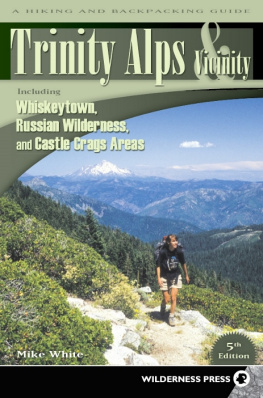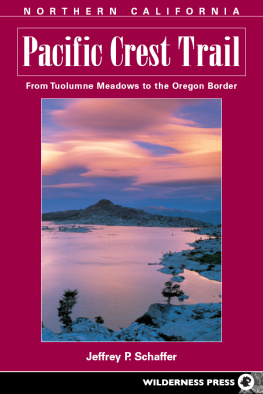ABOUT THE PHOTOGRAPHERS
Leon Nelson, a retired dentist who has lived in Redding, California, all his life, contrib-uted valuable assistance in updating this third edition, especially allowing the use of many of his photographs. Nelson cites backpacking as one of his many passions and continues to find excuses to frequently check out his favorite lakes in the Trinity Alps. His photo-graphs have been used on the covers of several USDA Forest Service maps for the Trinity Alps and Marble Mountains Wilderness Areas.
Paul Imperia, MD, is an outdoor photographer, adventurer, and athlete, and he gra-ciously shared many of his photos for this edition. After hiking, biking, skiing, fly-fishing, and traveling throughout the world, Imperia says the Trinity Alps remain one of his favorite places on Earth. He has been backpacking in the Trinities since 1991, when he moved to the Rogue Valley in Oregon, and where he is currently enjoying retirement.
I spent most of two seasons hiking trails in the Trinity Alps for this book. And while I kept seeing new sights, I also kept returning to familiar places Id been visiting since childhood: lakes I had been to before I was old enough to carry a pack; the trail I hiked with my dad when I was 8; the hike I did the year I got my first real backpack; the campsite I slept at the first time I hiked in Trinity on my own, shortly after getting my drivers license. During this period I tried to remember the first time I ever went hiking in the area. I couldnt. As far back as I can remember, Ive been hiking in the Trinity Alps. For that I am grateful to my parents, Bob and Elaine, for putting me on the right path when I was just learning to walk.
While hiking hundreds of miles of trails for this book, I discovered my childhood trips had barely scratched the surface of this vast wilderness. I got to rediscover the Trinity Alps all over again. Thanks to all the friends and strangers who made that possible. And thanks especially to my wife, Jen, who joined me even when there was no trail.
I still spend a couple of weeks a year in the Trinity Alps, and my own kids have hiked there while learning to walk and have backpacked to the lakes I enjoyed as a child. In the most important wayas a refuge of raw natureTrinity hasnt changed in the decades since I first started hiking there. But of course, nothing stays the same forever, so I was glad to check in with rangers and local hikers and revisit some trails myself while updating hike information for this third edition. And thanks, of course, to the folks at Falcon, without whom this project wouldnt be possible.
WILDERNESS PERMITS
All overnight visitors to the Trinity Alps Wilderness must obtain a wilderness permit before entering the backcountry. Permits are free and are available without reservation. Simply stop by one of the ranger stations on the way to the trailhead (see contact infor-mation below) and pick one up. If you arrive after hours, you can fill out a permit form at self-registration boxes located outside the stations. Self-registration kiosks are also avail-able at various locations, such as Coffee Creek Fire Station, but theyre not always stocked with permits so its best to call and check if you plan to use one of them. Campfire/stove permits are also required and are available where you get your wilderness permit. Always check to see if any special fire hazards or restrictions are in effect.
FOR MORE INFORMATION:
Shasta-Trinity National Forest Headquarters
(530) 226-2500
Hayfork Ranger Station
(530) 628-5227
McCloud Ranger Station
(530) 964-2184
Weaverville Ranger Station
(530) 623-2121
Harrison Gulch Ranger Station (Platina)
(530) 352-4211
Trinity County Chamber of Commerce
trinitycounty.com
USGS Map Distribution
(888) ASK-USGS (275-8747)
usgs.gov
Going into a wild area is like visiting a famous museum. You obviously do not want to leave your mark on an art treasure in a museum. If everybody going through the museum left one little mark, that piece of art would be quickly destroyedand of what value is a big building full of trashed art? The same goes for pristine wildlands. If we all left just one little mark on the landscape, the backcountry would soon be spoiled.
A wilderness can accommodate human use as long as everybody behaves responsibly. But a few thoughtless or uninformed visitors can ruin it for everybody who follows. All backcountry users have a responsibility to know and follow the rules of zero-impact camping. Enjoy the wild but leave no trace of your visit.
THREE FALCON PRINCIPLES OF ZERO IMPACT
Leave with everything you brought in.
Leave no sign of your visit.
Leave the landscape as you found it.
Pack it in/pack it out. Most of us know better than to litterin or out of the backcountry. Be sure you leave nothing, regardless of how small it is, along the trail or at your campsite. You should pack out everything, including orange peels, flip-tops, cigarette butts, and gum wrappers. Also pick up any trash others leave behind.
Stay on the main trail. Avoid cutting switchbacks and walking on trailside vegeta-tion. Dont pick up souvenirs such as rocks, antlers, or wildflowers. The next person wants to see them too, and collecting such souvenirs violates many regulations.
Avoid making loud noises on the trail (unless you are in bear country) or in camp.Be courteous. Remember: Sound travels easily in the backcountry, especially across water.
Bury your waste. Carry a lightweight trowel to bury human waste 6 to 8 inches deep and at least 300 feet from any water source. Pack out used toilet paper.
Go without a campfire. Carry a stove for cooking and a flashlight, candle lantern, or headlamp for light. For emergencies, learn how to build a no-trace fire.
Camp in obviously used sites when available. Otherwise, camp and cook on durable surfaces such as bedrock, sand, gravel bars, or bare ground.
As a leader of wilderness trips for youth, I always told my students to be prepared. For starters, this means carrying survival and first-aid materials, proper clothing, a compass, and a topographic mapand knowing how to use them. Many hikers these days also choose to carry a cell phone (reception is possible at high vantage points in the Trinity Alps, often where you can see Mount Shasta) and/or emergency communication devices that use satellites to enable rescue signals or contact with friends and family (available for rent or purchase).
Perhaps the second-best piece of safety advice is to tell somebody where youre going and when you plan to return. Pilots must file flight plans before every trip, and anybody venturing into the backcountry should do the same. File your flight plan with a friend or relative before taking off, and make sure they know who to call if you dont return as scheduled.
Close behind your flight plan and being prepared with proper knowledge and equip-ment is physical conditioning. Being fit not only makes wilderness travel more fun but also makes it safer. Here are a few more tips, and keep reading for more detailed advice on avoiding special hazards like lightning, hypothermia, river fords, and wild animals:



